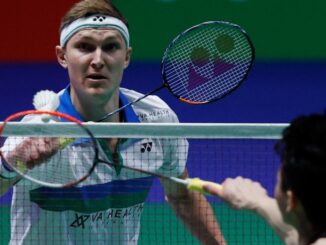
A racket is a must-have equipment when it comes to badminton. Some experienced players say that the outcome of a badminton tournament is mostly determined by the racket being used.
Thus, it is very important to choose the right one as it might be the difference between you and your opponent that will win you the game.
With that said, here are some of the things worth considering to ensure that you pick the most trusted rackets of badminton available.
- Your level of experience in the game
Different types are made for different kinds of players with regard to various factors such as physique and skills. If you are a beginner you should choose one which is easy to control.
Therefore, you should go for a 5U or even a 6U type. These weigh between 75g-79g and 70g-74g respectively. The lighter the racket the lesser the stress is that will be exerted on the arms and shoulders thus ensuring your safety.
A lighter one is also easy to maneuver thus will give you enough time to properly learn and master the basics of the game. Going for a heavier one, on the other hand, offers more power and is suitable for those playing intense games.
If you are a professional or well-experienced player then consider using a 3U design while playing one-on-one for more stability or a 5U design while playing two-on-two for quick reactions.

- The balance point
This is an important feature to consider as it widely affects the performance in a game situation. Based on the balance point, three classes of rackets can be derived, namely; head-heavy, head-light and even-balanced ones.
Head-heavy types weigh more at the head than the other parts hence offering great striking power at the expense of control. These are usually popular in games of intense nature. Head-light ones have a heavier handle than the other parts hence provide good control and less striking power.
They are suitable for fast-paced games as they support quick reactions. Even-balanced rackets as the name suggests strike a balance between the three parts hence are neutral. They are good for learners who are still trying to master the fundamentals. Information about the balance point is normally provided on the gear.
- Shape of the head
The head is often considered to be either isometric or conventional oval-shaped. These provide different accuracy.
The isometric head is square-shaped and has a larger ‘sweet spot’ than the conventional head which is oval. The sweet spot refers to the area at the center of the gear head, which provides maximum shot power, and accuracy of the gear.
The isometric head is an advancement from the conventional head and therefore you should opt for it.

- Flexibility of the shaft
Badminton playing gears come with shafts of different flexibility to cater for various kinds of players. For a perfect strike, the flexibility of the shaft should be directly proportional to the speed of your swing.
This will make sure that it is stiff enough to provide extra power for the strike while also ensuring that the shaft fully recoils before hitting the shuttlecock hence no energy is wasted. A highly skilled player with a lot of experience should choose one with a stiff shaft for proper delivery and pinpoint accuracy.
An amateur player with slow swings should choose one with a flexible shaft to cater for less energy strikes and control. See this link to read more about the influence of a racket’s flexibility: https://www.researchgate.net/publication/261578090_The_Influence_of_Tennis_Racket_Flexibility_and_String_Tension_on_Rebound_Velocity_Following_a_Dynamic_Impact
- The strings
Tension of the strings affects both the performance and durability of the racket. Low tension strings have a wider sweet spot than high tension strings hence are more preferred. High tension types, on the other hand, provide more striking force than low tension strings.
An easy way to measure the tension of the strings is by pressing your palm against the strings and observing how deep it will sink. Depth of around 1mm is the standard tension of most rackets.
String tension of 20-24lbs is recommended for beginners and 24-28lbs for professionals.
This also varies depending on the geographical regions due to differences in climate. In the tropics, temperature is high hence high tension strings are recommended to cater for expansion.
- The material it’s made of
The three main materials used in the manufacture of racket parts are steel, aluminum, and graphite.
All these have their pros and cons. Steel makes very strong badminton gears thus ensuring durability. The disadvantage is that they are heavy and less comfortable.
Aluminum makes lighter products than steel but are less durable. Graphite makes much lighter and flexible gears than both aluminum and steel but are very expensive.
- The type and size of the grip
The two main types of grip are towel and synthetic grips. Towel grips have a soft sponge-like feel, which is comfortable and also absorbs sweat thus providing a firm grip.
To ensure cleanliness they can be replaced or cleaned using sanitizers regularly. Synthetic grips are less comfortable but do not require regular replacement as they don’t absorb sweat.
When it comes to the grip size, large grip size occupies more space when held hence provide a tight grip which is suitable for delivering powerful strikes. Small grip size, on the other hand, offers a less tighter grip that is suitable for performing quick maneuvers easily.
- Type of badminton game you intend to play
Based on the properties of the playing gears, they are suited for different types of badminton plays.
For a slow-paced singles game, head-heavy rackets are recommended since the weight is a viable trade-off for the great striking power provided.
For a fast-paced doubles game, headlight types are perfect as they allow for easy control and performance of quick maneuvers that are usually required to win in this type of game. Click here to read more about the best way to shop for badminton rackets.

Conclusion
A badminton player is only as good as their performance, which is to a large extent dictated by the racket. You should get the necessary information about rackets before you select the one for you. What works for one player might not work for the other and therefore buying the type of racket used by your favorite professional player or world champion does not guarantee good performance. Consider the information above to ensure you choose the best badminton racket.


